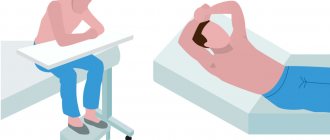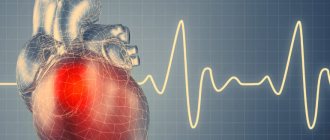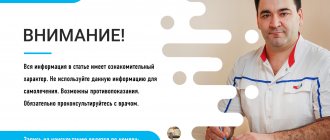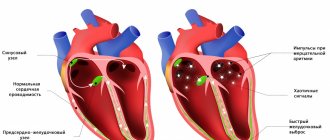Heart pain can arise from completely different reasons. Some pains do not pose a danger and can simply be tolerated, while other pains are strictly contraindicated and must be relieved immediately. How to find out what kind of pain you have? You need to see a doctor and undergo an examination, without waiting for obvious signs, at the slightest suspicion.
Diagnosis of heart pain
An experienced doctor can determine its origin based on the description of the pain. But to confirm the diagnosis you need to undergo an examination. First of all, an electrocardiogram (ECG) is done, including with physical activity. If no abnormalities are detected, the ECG is recorded throughout the day (24-hour monitoring).
If pain in the heart appears after a sore throat, then an ECG, echocardiography (ultrasound examination of the heart), and blood tests are required, which can reveal inflammation in the heart muscle.
If you have pain in the heart area, be sure to consult a doctor - he will help you figure out how serious it is. What methods are used today to study cardiac activity? There are quite a few of them, and the specific diagnostic set in each case is determined by the attending physician.
- The well-known ECG - taking a cardiogram - is a mandatory technique for any suspicion of heart disease. Stress ECG is also widely used - recording data during physical activity (usually velometry or treadmill test), as well as Holter ECG (when an electrocardiogram is taken during the day).
- Often, the doctor prescribes a graphical recording of heart sounds and noises (phonocardiography), a study of the valves and muscles of the heart, as well as the speed of blood flow in the heart cavities using ultrasound waves (echocardiography). Coronary arteries are studied using a radiopaque method (coronary angiography). How well the myocardium is supplied with blood can be determined by radionuclide diagnostics (scintigraphy).
- To exclude damage to other organs as the cause of heart pain, patients are prescribed a spinal examination (X-ray, computed tomography, MRI), consultation with an orthopedist, neurologist, gastroenterologist, and even a psychotherapist.
Experienced doctors know that some (and fairly accurate) conclusions can be drawn by listening carefully to the patient. When a person describes his feelings in detail, keeps and shows the doctor a kind of diary of the occurrence and nature of pain in the heart area, most likely the heart itself has nothing to do with it. Also, an “external” source of pain is indicated by patient reports of varying durations of attacks, a strong and very disturbing heartbeat - of course, if the person does not have heart failure. But if the patient perfectly remembers all his painful sensations, but describes them sparingly and reluctantly, there is a high chance of diagnosing serious heart disease.
In any case, remember: the main thing to do if your heart hurts is to consult a specialist and give him the right to draw conclusions about your health.
Heart pain can be a consequence of cardioneurosis, a disease of the nervous system. They intensify under stress and have a constant aching character. Such pain is relieved with sedatives (for example, valocardine or valerian). But you need to remember that only a doctor can make a diagnosis of cardioneurosis after an examination.
Pain in the heart due to inflammation of the heart muscle (myocarditis) is prolonged, aching, sometimes it is combined with stabbing pains, they are usually felt not behind the sternum, but to the left of it. The pain intensifies with physical activity, usually combined with shortness of breath, a feeling of “interruptions” in the heart’s work and its “fading”, weakness, malaise, and sometimes with a slight fever. Such pains often appear 2-3 weeks after a sore throat or other illness. You can’t joke with these pains - you need to see a doctor immediately, the treatment will be long-term.
Heart pain can occur when the arteries that supply nutrients and oxygen to the heart muscle spasm (compress). Such attacks of pain are called angina pectoris, they are very dangerous and cannot be tolerated.
Heart pain includes:
- Pain due to coronary heart disease (angina)
. The cause of these pains is oxygen “starvation” of the heart cells when the load on it increases. The lack of oxygen supply is caused by a narrowing of the vessels supplying the heart due to the deposition of fat-like accumulations (atherosclerotic plaques) on their walls, as a result of which they lose the ability to expand and provide blood flow adequate to the needs of the heart. Such pain, as a rule, occurs during physical exertion or psycho-emotional stress, has a pressing or squeezing nature, is often localized behind the sternum, less often in the left half of the chest, is relieved (stopped) by taking nitro drugs or when the load is stopped, and is short-term in nature (several minutes) . - Pain during myocardial infarction.
Their character is similar to the pain of angina pectoris, but they are usually longer lasting, may be accompanied by shortness of breath, cold sweat, and are not relieved by taking nitroglycerin. The cause of such pain is a blockage of one or more arteries supplying the heart by a blood clot (thrombus). - Pain similar to angina pectoris can
also occur in a number of other conditions characterized by an increased load on the heart muscle: for example, with a hypertensive crisis, heart defects (aortic stenosis), hypertrophic cardiomyopathy. In such cases, the cause of pain is overload of the heart with sufficient blood supply. - Cardialgia
is pain in the heart that is not associated with either ischemia or myocardial overload, but occurs in the presence of minimal structural changes in the heart, often congenital (additional chords of the left ventricle, mitral valve prolapse), or when the regulation of its activity through the nervous system is impaired ( vegetative-vascular dystonia).
A large group of causes of chest pain have nothing to do with the heart. In these cases, pain is provoked by damage to other organs. Let's list some of them:
- Osteochondrosis of the cervical and thoracic spine
is the cause of the so-called “vertebrogenic cardialgia,” which also has similarities with angina pectoris. The pain is intense and prolonged, can be localized behind the sternum and in the left half of the chest, and radiate to the left arm. However, unlike angina pectoris, pain in thoracic osteochondrosis is associated with changes in body position and intensifies when turning the head or moving the arms; - Gastroesophageal reflux disease (GERD).
Accompanied by heartburn - a burning sensation in the chest that occurs when acidic gastric juice enters the esophagus from the stomach. May be accompanied by a sour taste in the mouth and belching, most often occurs when bending over or in a lying position, and can be relieved by taking antacids (Almagel, Maalox); - Pleurisy.
In various diseases, but more often with pneumonia, inflammation occurs of the membrane lining the inside of the chest cavity and covering the lungs. This pain is acute, localized in one place, intensifies with breathing and coughing; - Tietze syndrome.
Pain in this condition occurs due to inflammation of the cartilage, most often in the places where it is attached to the sternum, and thus imitates an attack of angina. In such cases, palpation of the site of pain helps differentiate one condition from another - with Tietze syndrome, the inflamed cartilage is sharply painful, with angina pectoris - palpation does not affect the intensity of pain; - Chest pain
can be a consequence of muscle diseases. Such pains, as a rule, are provoked by turns of the torso, movements of the arms; - Bruises and fractures of the ribs
can also cause pain, sometimes very intense; - Diseases of the esophagus.
Pain can also occur with spasm of the esophagus, achalasia (a disease of the lower esophageal valve that interferes with the passage of food), and such pain goes away after the patient takes nitroglycerin, which relaxes the muscles of the esophagus, which makes it difficult to diagnose the condition; - Shingles.
It is a herpetic infection that affects the nerve endings and causes severe pain in the chest; - Diseases of the gallbladder and pancreas.
Gallstones or inflammation of the gallbladder (cholecystitis) and pancreas (pancreatitis) can cause pain in the epigastric region, radiating to the heart; - Pulmonary embolism.
This dangerous condition develops when a blood clot enters the pulmonary artery, through which blood flows to the lungs, blocking the flow of blood through the lungs to the heart. As a result, severe dull pain in the chest, shortness of breath appears, blood pressure drops sharply, and loss of consciousness is possible.
Pain of any nature and location in the chest, especially if it occurs for the first time, should alert a person and cause immediate consultation with a doctor. After which it is necessary to undergo all examinations prescribed by the doctor to determine the cause of the pain. It is most important to diagnose cardiac pathology as early as possible, since it is this pathology that is associated with the greatest risk to the patient’s life.
Angina pectoris
Attacks of angina pectoris occur first during exercise or stress (this is called angina pectoris), and then at rest (rest angina pectoris). In typical cases, the pain is squeezing or pressing in nature and manifests itself either in the upper part of the sternum or to the left of it. Pain can radiate to the left arm, the left half of the face and neck, to the lower jaw, left ear, to the left shoulder blade, sometimes to the right shoulder or both shoulders and both arms, and the back. Sometimes the pain spreads to the left side of the abdomen and lower back, and to the legs. The onset of pain is rarely sudden; usually the pain is of an increasing nature, lasts for several minutes, then disappears. This pain is different in that it can be relieved with nitroglycerin, a drug that relieves spasm of the coronary arteries (which supply blood to the heart muscle).
If such pain occurs at least once, the patient should consult a doctor, get examined and clearly know what to do during an attack. During an attack of angina, you need to:
- take a nitroglycerin tablet (under the tongue);
- lie down, open a window or window;
- if after 2 minutes the pain has not decreased, then take another nitroglycerin tablet and call an ambulance. Nitroglycerin begins to act within 1-2 minutes, its vasodilating effect lasts 20-30 minutes. Remember: neither Corvalol nor validol will help with angina - only nitroglycerin!
Causes of the disease
At the level of the thoracic part of the spine, nerves emerge from the spinal cord symmetrically on both sides, following under each rib. They innervate the skin and muscles of the corresponding area, and have connections with nerves going to the internal organs.
Osteochondrosis is the most common cause of a pinched nerve in the chest. With this disease, the height of the intervertebral discs decreases, and the shock-absorbing properties of the cartilage are lost. There are often bone deformities that increase pressure on the nerve. Often the disease develops against the background of scoliosis – a sideways curvature of the spine.
Diabetes mellitus, atherosclerosis, arterial hypertension, chronic renal and endocrine diseases, age-related changes lead to damage to blood vessels and nerves. This also worsens the working conditions of the muscles, ligaments, discs, and joints of the spine.
Prolonged stay in a forced position, heavy lifting, uneven load on the back (carrying a heavy bag in one hand) provoke the appearance of pain. A pinched nerve in the thoracic region can be on the left, right, or both sides.
Myocardial infarction
If an attack of angina pectoris lasts a long time, then the heart muscle, not receiving nutrients and oxygen, begins to quickly deteriorate, its necrosis (death) occurs, this is myocardial infarction. That is why you should never tolerate pain due to angina pectoris.
Myocardial infarction is manifested by attacks of severe pain in the chest, which are not relieved by nitroglycerin. The duration of this pain is from 20-30 minutes to several hours. In such cases, the sooner the patient receives medical assistance, the greater the chance of recovery.
What is important to the patient?
- pain behind the sternum and in the heart area can be a consequence of angina pectoris or myocardial infarction - conditions that directly threaten a person’s life;
- if chest pain occurs, it is necessary to seek medical help from qualified specialists as soon as possible, since delay in this situation can cost a person’s life;
- Only a cardiologist can decide on a cardiac or non-cardiac cause of chest pain after conducting the necessary examination;
- Treatment of patients with coronary heart disease should be carried out only in the cardiology department of the hospital, equipped with an intensive care ward.







